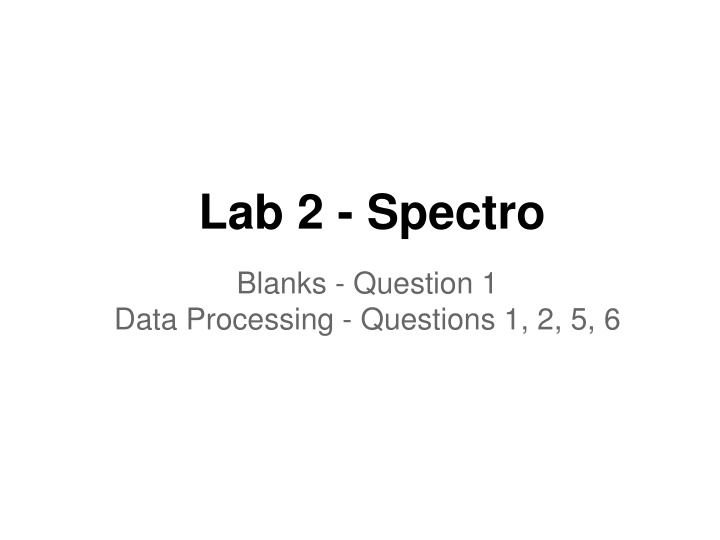
SpectroBlanks Data Processing: Analyzing Absorbance Coefficients
Explore the spectral signatures of RO water, Milli-Q water, and tap water, comparing their absorbance coefficients and fit models. Discover key findings and trends in spectroscopic analysis for water samples with varying compositions.
Download Presentation

Please find below an Image/Link to download the presentation.
The content on the website is provided AS IS for your information and personal use only. It may not be sold, licensed, or shared on other websites without obtaining consent from the author. If you encounter any issues during the download, it is possible that the publisher has removed the file from their server.
You are allowed to download the files provided on this website for personal or commercial use, subject to the condition that they are used lawfully. All files are the property of their respective owners.
The content on the website is provided AS IS for your information and personal use only. It may not be sold, licensed, or shared on other websites without obtaining consent from the author.
E N D
Presentation Transcript
Lab 2 - Spectro Blanks - Question 1 Data Processing - Questions 1, 2, 5, 6
Blanks - 1 -RO has a similar spectral signature to Milli-Q except near 200nm -Tap water has a different spectral signature at wavelengths less than 400nm because there are different components in tap water. -Keep cuvette clean and properly placed by rinsing the cuvette 3x, using a lens wipe to clean the optical lens, placing the cuvette closest to the detector and orienting it in the same direction each time. -Milli-Q water gives the lowest reading
Absorption Coefficient, 1cm pathlength, Field Samples Wavelength 705-725nm
DRE02u General model Exp2: f(x) = a*exp(b*x) + c*exp(d*x) Coefficients (with 95% confidence bounds): a = 779 (695.2, 862.9) b = -0.01726 (-0.01769, -0.01684) c = 9.727 (8.934, 10.52) d = -0.00457 (-0.004698, -0.004443) Goodness of fit: SSE: 0.7182 R-square: 0.9993 Adjusted R-square: 0.9993 RMSE: 0.03805
DRE07u General model Exp2: f(x) = a*exp(b*x) + c*exp(d*x) Coefficients (with 95% confidence bounds): a = 438.8 (408.9, 468.7) b = -0.0147 (-0.01497, -0.01444) c = 5.441 (5.092, 5.789) d = -0.002897 (-0.002991, -0.002803) Goodness of fit: SSE: 0.7661 R-square: 0.9994 Adjusted R-square: 0.9994 RMSE: 0.0393
BP02u General model Exp2: f(x) = a*exp(b*x) + c*exp(d*x) Coefficients (with 95% confidence bounds): a = 3449 (3310, 3588) b = -0.01574 (-0.01589, -0.01559) c = 19.62 (18.95, 20.29) d = -0.002182 (-0.002233, -0.00213) Goodness of fit: SSE: 9.883 R-square: 0.9997 Adjusted R-square: 0.9997 RMSE: 0.1412
Linear model Poly1: f(x) = p1*x + p2 Coefficients (with 95% confidence bounds): p1 = -0.01149 (-0.01162, -0.01137) p2 = 7.918 (7.848, 7.988) Goodness of fit: SSE: 20.38 R-square: 0.9854 Adjusted R-square: 0.9854 RMSE: 0.2023
Absorbance and Absorption Coefficient 5cm pathlength
Absorption Coefficient, 5cm pathlength, Field Samples Wavelength 705-725nm
BP02u General model Exp1: f(x) = a*exp(b*x) Coefficients (with 95% confidence bounds): a = 1.555e+04 (1.513e+04, 1.597e+04) b = -0.01576 (-0.01584, -0.01568) Goodness of fit: SSE: 509.5 R-square: 0.9988 Adjusted R-square: 0.9988 RMSE: 1.011
DRE02u General model Exp1: f(x) = a*exp(b*x) Coefficients (with 95% confidence bounds): a = 2941 (2870, 3012) b = -0.01713 (-0.0172, -0.01706) Goodness of fit: SSE: 4.977 R-square: 0.9992 Adjusted R-square: 0.9992 RMSE: 0.09997
DRE07u General model Exp1: f(x) = a*exp(b*x) Coefficients (with 95% confidence bounds): a = 1722 (1638, 1805) b = -0.01523 (-0.01538, -0.01509) Goodness of fit: SSE: 29.93 R-square: 0.9959 Adjusted R-square: 0.9959 RMSE: 0.2452
Bias removal General model Exp1: f(x) = a*exp(b*x) Coefficients (with 95% confidence bounds): a = 1.555e+04 (1.513e+04, 1.597e+04) b = -0.01576 (- 0.01584, -0.01568) General model Exp1: f(x) = a*exp(b*x) Coefficients (with 95% confidence bounds): a = 1722 (1638, 1805) b = -0.01523 (- 0.01538, -0.01509) Goodness of fit: SSE: 29.93 R-square: 0.9959 Adjusted R-square: 0.9959 RMSE: 0.2452 Goodness of fit: SSE: 509.5 R-square: 0.9988 Adjusted R-square: 0.9988 RMSE: 1.011
Absorbance and Absorption Coefficient 10cm pathlength
Absorption Coefficient, 10cm pathlength, Field Samples Wavelength 705-725nm
Data Processing - 2 - Yes - Yes because CDOM only absorbs in the blue so the residual scattering is due to air bubbles or colloids and therefore should have value 0 in the NIR. - Yes, see Bias Removal 5 - There doesn't appear to be anything in the water smaller than 1 micron , therefore the 0.2 vs 0.7 filter pore size does not have an impact.
Data Processing - 6 - Absorption increases linearly with pathlength.
